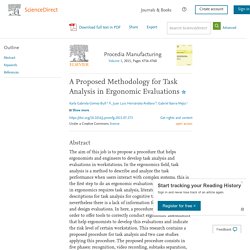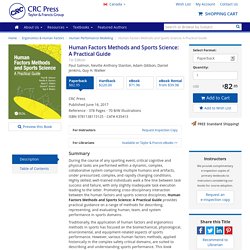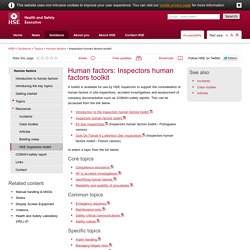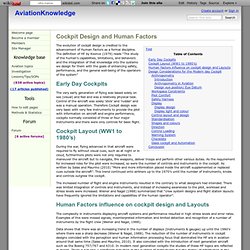

A Proposed Methodology for Task Analysis in Ergonomic Evaluations. JavaScript is disabled on your browser.

Please enable JavaScript to use all the features on this page. Abstract The aim of this job is to propose a procedure that helps ergonomists and engineers to develop task analysis and evaluations in workstations. In the ergonomics field, task analysis is a method to describe and analyze the task performance when users interact with complex systems, this is the first step to do an ergonomic evaluation.
Most of the areas in ergonomics requires task analysis, literature contains clear descriptions for task analysis for cognitive tasks, and nevertheless there is a lack of information for biomechanics and design evaluations. Keywords Task analysis Methodology Ergonomic evaluation References P. C. G. R. M. S. SUPPORT FH 16 Nov 2016 HAD. FH sefa. Human Factors Methods and Sports Science: A Practical Guide. Summary During the course of any sporting event, critical cognitive and physical tasks are performed within a dynamic, complex, collaborative system comprising multiple humans and artifacts, under pressurized, complex, and rapidly changing conditions.

Highly skilled, well-trained individuals walk a fine line between task success and failure, with only slightly inadequate task execution leading to the latter. Promoting cross-disciplinary interaction between the human factors and sports science disciplines, Human Factors Methods and Sports Science: A Practical Guide provides practical guidance on a range of methods for describing, representing, and evaluating human, team, and system performance in sports domains. Traditionally, the application of human factors and ergonomics methods in sports has focused on the biomechanical, physiological, environmental, and equipment-related aspects of sports performance.
Table of Contents Introduction Introduction.
HF interactions. Human Factors in Architecture - Lectures. Tel.archives-ouvertes. Anglais-Aeronautique-1. Human factors/ergonomics – Inspectors human factors toolkit. A toolkit is available for use by HSE inspectors to support the consideration of human factors in site inspections, accident investigations and assessment of company documentation such as COMAH safety reports.

This can be accessed from the link below. or select a topic from the list below: Mission SGS - INGENIERIE FORMATION OBEA. Www.observatoire-metiers-aerien.fr/fichier-utilisateur/fichiers/documents/Rapport emploi 2011 - modifié le 22_02_2013.pdf. Cockpit Design and Human Factors - AviationKnowledge. The evolution of cockpit design is credited to the advancement of Human Factors as a formal discipline.

The definition of HF by Koonce (1979) reads “The study of the human’s capabilities, limitations, and behaviors and the integration of that knowledge into the systems we design for them with the goals of enhancing safety, performance, and the general well-being of the operators of the system” The very early generation of flying was based solely on see (visual) and feel and was a relatively physical task. Dangers et risques pour les travailleurs dans le secteur du transport aérien. Human Factors and Ergonomics Society: Product List. Restitution ADECCopy. Observatoire Prospectif des Métiers et des Qualifications de l'Aérien. Juin2012_Rapport_besoins_RH_Aero__Spatial. Juin2012_Rapport_besoins_RH_Aero__Spatial. Facteurs humains : Sécurité aéronautique et risques interculturels. Cet article de Benjamin PELLETIER est à mettre en perspective avec le contenu du dernier rapport sur la sécurité aérienne (2009) de la DGAC, qui mentionne à propos du transport aérien public en France : « Une analyse statistique simple des accidents mortels survenus aux transporteurs français tend, en effet, à indiquer que notre pays reste en deçà des performances d’Etats européens comparables… ».

Dans ce même document on retrouve le taux d’accidents mortels par million d’heures de vol qui montre que sur les dix dernières années le taux d’accident du transport aérien public en France est environ trois fois plus élevé que celui des pays les plus performants (on retrouve ce ratio dans d’autres documents officiels). Dans ce même rapport il est précisé également que : « La sécurité de l’aviation générale n’a pas, elle non plus, évolué dans un sens favorable ». JG Charrier Vous pouvez retrouver tous les articles de Benjamin sur son site : Gestion des risques interculturels.
GESTION DES AGES ET PUBLICS AERONAUTIQUES. [SUJET LEXICAL] Language et abréviations aéronautiques. Il y a des abréviations qui se répètent le long de ce topic ,je demande à tout nouveau membre du forum de passer par ici ( le bar des nouveaux en quelques sorte ) et surtout n'hésitez pas à demander des infos ou explications en cas de besoin CCAA Civil Aviation AuthorityCAS-T Temporary Class A/B ControlledAirspaceCAT Commercial Air TransportCPDLC Controller Pilot DatalinkCommunicationsc/s CallsignCTA Control AreaCTR Control ZoneCVSM Conventional Vertical Separation Minimum DDAP Directorate of Airspace PolicyDEO Duty Engineering OfficerD/F Direction FindingDfT Department for TransportDME Distance Measuring EquipmentD&D RAF Distress and Diversion CellsEEAT Expected Approach TimeETA Estimated Time of ArrivalETD Estimated Time of Departure FFAF Final Approach FixFIR Flight Information RegionFIS Flight Information Service(s)FL Flight LevelFPPS Flight Plan Processing Systemft Foot (feet)GGA General AviationGAT General Air TrafficGMC Ground Movement ControlGPWS Ground Proximity Warning System.
![[SUJET LEXICAL] Language et abréviations aéronautiques](http://cdn.pearltrees.com/s/pic/th/abreviations-aeronautiques-104970390)
Guide_fh.pdf.